This article needs additional citations for verification .(November 2024) |

The bombing of Augsburg in World War II included two British RAF and one USAAF bombing raids against the German city of Augsburg on 17 April 1942 and 25/26 February 1944.
This article needs additional citations for verification .(November 2024) |

The bombing of Augsburg in World War II included two British RAF and one USAAF bombing raids against the German city of Augsburg on 17 April 1942 and 25/26 February 1944.

In April 1942 RAF Bomber Command targeted the MAN U-boat diesel engine factory at Augsburg in Operation Margin. They hoped to take advantage of the capabilities of the new Avro Lancaster. [1] The target was a long distance inside Germany, and a night-time attack would not have been as accurate, so the plan was to attack by day and cross enemy territory at low level. The bomber force was drawn from No. 44 (Rhodesia) Squadron at RAF Waddington and No. 97 Squadron at RAF Woodhall Spa. Each provided a flight of six aircraft. They practised low flying for a week. Thirty Douglas Boston medium bombers and a large Fighter Command effort were dispatched to targets in Northern France intending to draw off German fighters. One Boston was lost in these diversionary activities.
Flying at around 50 ft (15 m), the bombers crossed France but the aircraft of 44 Squadron, under Squadron Leader John Dering Nettleton, flew close by an airfield of II Gruppe/Jagdgeschwader 2 . German fighters coming in to land set off in pursuit and shot down four Lancasters. The two remaining bombers flew on and attacked the target with four 1,000 lb (450 kg) bombs each. One was hit by flak and crash-landed with the loss of three of the crew. The other, Nettleton's, flew back. The second six, from 97 Squadron, attacked shortly after in two sections of three. The first attacked at roof height, flying lower after dropping their load to evade flak on the way out but one was hit and crashed exploding. Of the last three aircraft, two were hit and caught fire. One exploded after completing the attack, the others had also completed the bomb run and were able to return home. In the course of the raid, seven of the 12 Lancasters had been shot down with the loss of 49 crewmen, 37 killed and 12 taken prisoner. Seven bombers were claimed by Hpt. Walter Oesau (2), Fw. Otto Pohl (2), Fw. Alexander Bleymüller, Hptm. Karl-Heinz Greisert and Fw. Ernst Bosseckert.
Only two of the first formation of Lancasters dropped their bombs on the factory. Five of the next dropped their bombs. After attacking the surviving Lancasters flew home at higher level under cover of darkness. Squadron Leader Nettleton returned in a badly damaged aircraft, landing near Blackpool. For his outstanding determination and leadership, Nettleton, who had nursed his crippled Lancaster aircraft back to England, would be awarded the Victoria Cross later that same month. Many of the other officers and men who had survived the mission received recognition with the award of Distinguished Service Orders, Distinguished Flying Crosses and Distinguished Flying Medals. [2]
The operation had propaganda value to the British public (having proved that Bomber Command could reach distant targets within Germany). However, Lord Selborne, the Minister of Economic Warfare, was infuriated that the target had not been one of those specified by his Ministry for attack. Post-war analysis indicated the damage inflicted on the enemy was minor; five of the bombs dropped had failed to explode. Eight machine tools were destroyed out of a total of 2,700, and five cranes out of 558. [3] [4] [5] Courageous men and valuable aircraft had been lost although Bomber Command had already learned not to send unescorted bombers on such sorties. Another lesson was that the Lancaster bomber's rifle-calibre machine guns had proved quite inadequate against enemy fighters that were fitted with self-sealing fuel tanks. [4] [6] [7] [8]
In a final Big Week mission (#235), the Eighth Air Force bombed the Augsburg Messerschmitt works during the day on 25 February 1944. [9] [ full citation needed ] That night (25/26 February 1944), RAF Bomber Command followed with 594 aircraft and destroyed large parts of the centre of Augsburg. [10] 21 RAF aircraft, 3.6% of the force was lost (at least four due to collision). [10]
The last bombings killed 730 people and injured 1,335; 85,000 were left homeless, and nearly a quarter of all homes had been destroyed. There were 246 "large or medium sized" and 820 small fires. Due to the frozen hydrants and water surfaces (the temperature was minus 18 degrees Celsius) fire fighting was difficult. [10]
During the Christmas holiday of 2016, 50,000 Augsburg residents were evacuated to remove a 3.8 tonne dud bomb. [11]

The Avro Lancaster, commonly known as the Lancaster Bomber, is a British Second World War heavy bomber. It was designed and manufactured by Avro as a contemporary of the Handley Page Halifax, both bombers having been developed to the same specification, as well as the Short Stirling, all three aircraft being four-engined heavy bombers adopted by the Royal Air Force (RAF) during the same era.
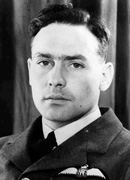
John Dering Nettleton, VC was a South African officer in the Royal Air Force (RAF) during the Second World War. He is most famous for leading the Augsburg raid, a daylight attack against the MAN U-boat engine plant in Augsburg on 17 April 1942. For his role in this mission he was awarded the Victoria Cross, the highest award for gallantry in the face of the enemy that can be awarded to British and Commonwealth forces.
The Pathfinders were target-marking squadrons in RAF Bomber Command during World War II. They located and marked targets with flares, at which a main bomber force could aim, increasing the accuracy of their bombing. The Pathfinders were normally the first to receive new blind-bombing aids such as Gee, Oboe and the H2S radar.
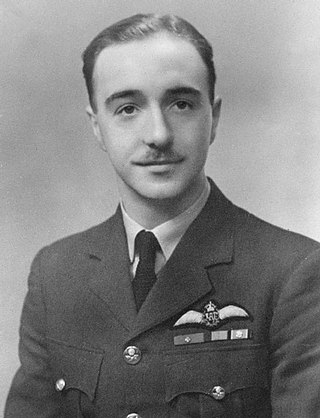
William Reid was a Scottish recipient of the Victoria Cross, the highest and most prestigious award for gallantry in the face of the enemy that can be awarded to British and Commonwealth forces. He earned his Victoria Cross as a pilot in the Royal Air Force Bomber Command during the Second World War.

Squadron Leader Ian Willoughby Bazalgette was a Canadian-British pilot in the Royal Air Force during the Second World War. On 4 August 1944, while piloting an Avro Lancaster in a pathfinder role, Bazalgette and crew flew to Trossy St. Maximin in France to mark a V-1 flying bomb storage cave. Bazalgette's Lancaster was severely damaged by flak prior to arrival at the target and quickly set on fire. Despite the condition of his aircraft, Bazalgette continued to the target and accurately dropped his markers. After completing the task, Bazalgette ordered his crew to bail out, however, two members of the crew were wounded and unable to jump. Rather than saving himself and leaving the two men to die, Bazalgette attempted to land the burning plane to save his two crew members. Bazalgette landed the plane, but it exploded almost immediately upon alighting, killing all three airmen. For his actions, Bazalgette was posthumously awarded the Victoria Cross.
Robert Anthony Maurice Palmer, was a bomber pilot in the Royal Air Force and a posthumous English recipient of the Victoria Cross, the highest award for gallantry in the face of the enemy that can be awarded to members of British and Commonwealth forces. His award was the result of his valour during the Allied action over Germany during the Second World War.

No. 486 (NZ) Squadron was a fighter squadron established for service during the Second World War. It was a New Zealand squadron formed under Article XV of the Empire Air Training Plan. Although many of its flying personnel were largely drawn from the Royal New Zealand Air Force, the squadron served in Europe under the operational and administrative command of the Royal Air Force.
No. 90 Squadron RAF is a squadron of the Royal Air Force.

No. 35 Squadron was a squadron of the Royal Air Force.
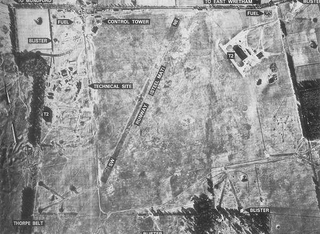
Royal Air Force East Wretham or more simply RAF East Wretham is a former Royal Air Force station located 6 miles (9.7 km) northeast of Thetford, Norfolk, England.
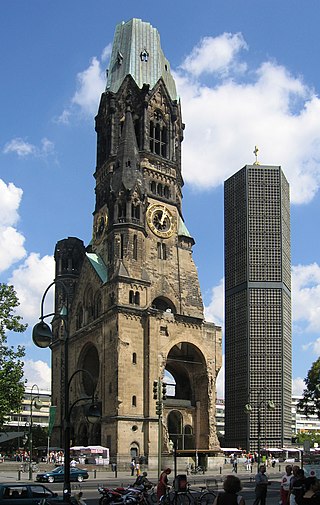
The Battle of Berlin was a bombing campaign against Berlin by RAF Bomber Command, along with raids on other German cities to keep German defences dispersed and which was a part of the bombing of Berlin during the strategic bombing of Germany in the Second World War. Air Chief Marshal Arthur Harris, Air Officer Commanding-in-Chief (AOC-in-C) Bomber Command, believed that "we can wreck Berlin from end to end if the USAAF come in with us. It will cost us between 400 and 500 aircraft. It will cost Germany the war".
The bombing of Stuttgart in World War II was a series of 53 air raids that formed part of the strategic air offensive of the Allies against Germany. The first bombing occurred on August 25, 1940, and resulted in the destruction of 17 buildings. The city was repeatedly attacked over the next four and one-half years by both the RAF and the 8th Air Force as it had significant industrial capacity and several military bases, and was also a center of rail transportation in southwestern Germany. Stuttgart endured 18 large-scale attacks by the Royal Air Force (RAF) during the war, during which 21,016 long tons (21,353 t) of bombs were dropped on the city, but the RAF concluded that its attacks against Stuttgart were not as effective as they could have been:
Stuttgart's experience was not as severe as other German cities. Its location, spread out in a series of deep valleys, had consistently frustrated the Pathfinders and the shelters dug into the sides of the surrounding hills had saved many lives.

No. 467 Squadron RAAF was a Royal Australian Air Force bomber squadron, active over North West Europe during World War II. Formed in November 1942 as an Article XV Squadron in Britain, the squadron was notionally an Australian squadron under the command of the Royal Air Force, and consisted of a mixture of personnel from various Commonwealth nations. After becoming operational in early 1943, the squadron flew operations in Occupied Europe until the end of the war flying Avro Lancaster heavy bombers. It was scheduled to deploy to the Far East to take part in further operations against Japan, but the war ended before it could complete its training and the squadron was disbanded in September 1945.

The de Havilland Mosquito was a British light bomber that served in many roles during and after the Second World War. Mosquito-equipped squadrons performed medium bomber, reconnaissance, tactical strike, anti-submarine warfare and shipping attack and night fighter duties, both defensive and offensive. Mosquitos were widely used by the RAF Pathfinder Force, which marked targets for night-time strategic bombing. Despite an initially high loss rate due to low-level daylight attack operations, the Mosquito ended the war with the lowest losses of any of the aircraft types in RAF Bomber Command service.
Ernst-Georg Drünkler was a German Luftwaffe military aviator during World War II, a night fighter ace credited with 47 aerial victories, including two by day, claimed in 102 combat missions making him the thirtieth most successful night fighter pilot in the history of aerial warfare. The majority of his victories were claimed over the Western Front in Defense of the Reich missions against the Royal Air Force's Bomber Command.
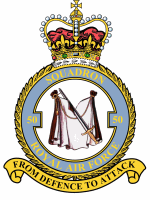
No. 50 Squadron was a squadron of the Royal Air Force. It was formed during the First World War as a home defence fighter squadron, and operated as a bomber squadron during the Second World War and the Cold War. It disbanded for the last time in 1984.
Operation Hedge-hop was a World War II British Royal Air Force raid on a submarine engine factory located in Augsburg, Germany. The attack occurred on April 17, 1942, during daylight hours. The name Hedge-hop refers to the fact that the bombers that participated in the operation had to fly at very low altitudes and were exposed to a significant amount of enemy fire.

The Augsburg Raid, also referred to as Operation Margin, was an attack by the Royal Air Force (RAF) on the Maschinenfabrik Augsburg-Nürnberg (MAN) U-boat engine plant in Augsburg during the daylight hours of 17 April 1942. It was carried out by No. 44 (Rhodesia) Squadron and No. 97 Squadron, both of which were equipped with the new Avro Lancaster. The speed of the Lancaster and its large bombload capacity gave reason for optimism that the raid might succeed. It was the first of the attacks upon German industry in Augsburg.

Patrick Arthur Dorehill, was an officer in the Royal Air Force. A bomber pilot, he flew as flight engineer for John Nettleton during the Augsburg raid, where they carried out a daring daylight attack against the MAN U-boat engine plant at Augsburg in southern Germany, earning him an immediate DFC and his captain the Victoria Cross. He completed two full combat tours as a bomber pilot. With his commitment to combat flying completed, he was transferred to the BOAC where he flew transports. Following the war Dorehill had a lengthy career as a commercial airline pilot.